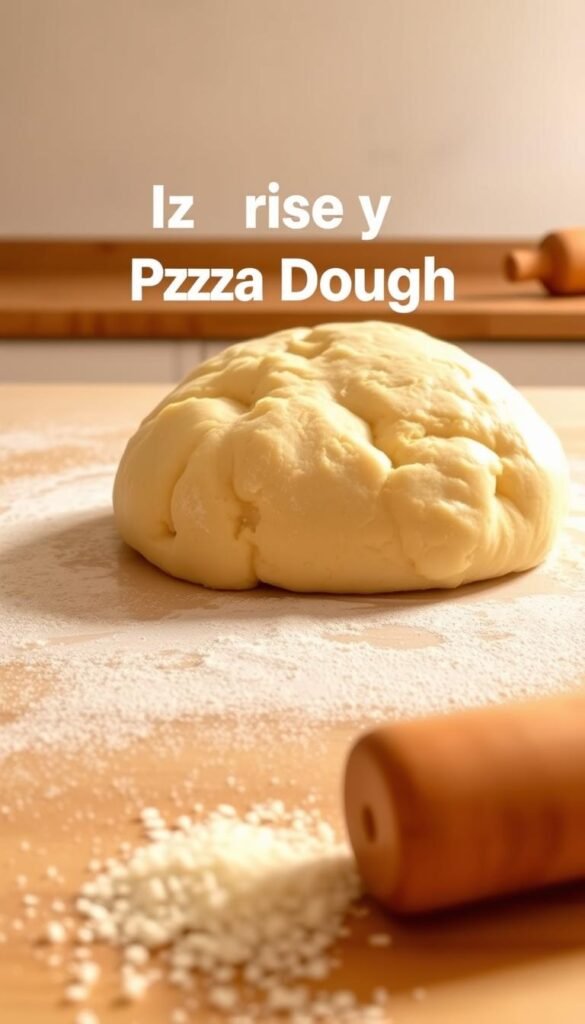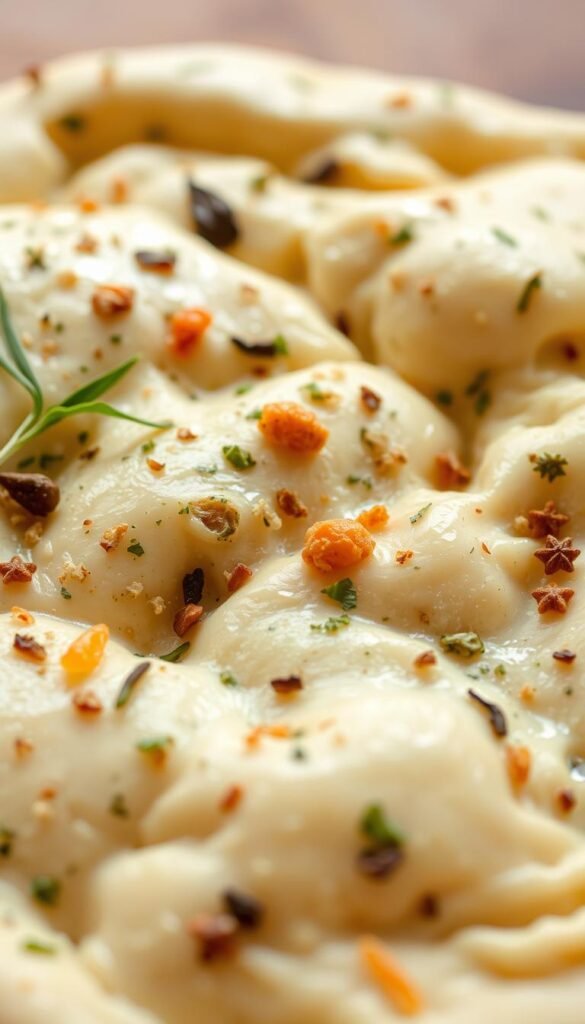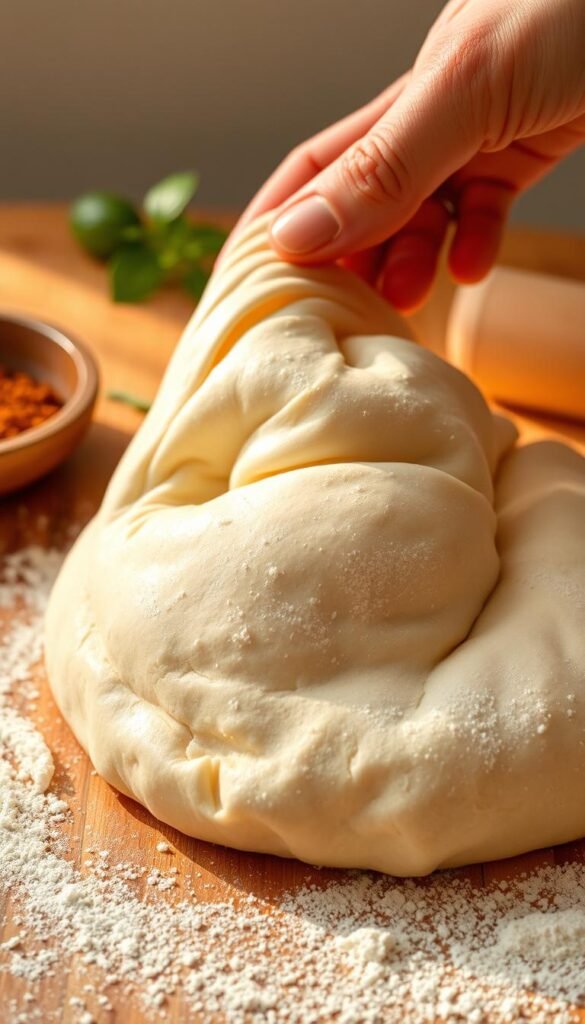25 Quick Pizza Dough Recipes for Fast Homemade Pizza
Making homemade pizza can be a daunting task, but what if you could have a delicious pie on the table in under an hour? With the average American consuming 46 slices of pizza per year, it’s no wonder that quick pizza dough recipes are in high demand.
These fast pizza recipes are designed to simplify the process, offering a variety of dough options that cater to different tastes and dietary needs. Whether you’re a busy weeknight cook or a pizza enthusiast, these recipes will revolutionize your pizza-making experience.
Key Takeaways
- Discover 25 different quick pizza dough recipes for a variety of tastes and dietary needs.
- Learn essential techniques for making perfect homemade pizza every time.
- Explore ingredient substitutions and troubleshooting tips for common pizza-making issues.
- Enjoy fast pizza recipes that can be prepared in under an hour.
- Find the perfect homemade pizza recipe for your next dinner or gathering.
The Art of Quick Pizza Dough
The art of making quick pizza dough lies in understanding the nuances of fast-acting leavening agents and their impact on the final product. Quick pizza dough techniques have gained popularity for their ability to produce delicious homemade pizzas in a fraction of the time required for traditional dough recipes.
One of the key factors that differentiate quick doughs from their traditional counterparts is the use of fast-acting leavening agents. These agents allow the dough to rise quickly, but they can also affect the texture and flavor of the crust.
Why Quick Doughs Are Different
Quick doughs are distinct from traditional pizza doughs in several ways. The rapid rise time, often achieved through the use of instant yeast or baking powder, results in a different gluten development pattern. This can lead to a crust that is less chewy than its slow-fermented counterpart. Additionally, the flavor profile of quick doughs may be less complex due to the shorter fermentation time.
The use of fast-acting leavening agents can also impact the texture of the crust, making it potentially more prone to cracking or less crispy than traditional dough.
Setting Expectations for Fast Pizza
When making quick pizzas, it’s essential to set realistic expectations. While quick doughs can produce delicious results, they may not match the quality of slow-fermented doughs in terms of flavor complexity and texture. However, with the right techniques and ingredients, quick pizzas can still be incredibly satisfying.
Understanding the trade-offs involved in quick pizza making allows home cooks to make informed decisions about their recipes and techniques. By adjusting expectations and using the right ingredients, anyone can create delicious homemade pizzas in no time.
Essential Ingredients and Tools for Fast Pizza Dough
The key to fast pizza dough lies in the ingredients and tools you use. Making pizza dough quickly doesn’t mean sacrificing quality; it’s about having the right components and equipment to streamline the process.
Must-Have Ingredients
To make quick pizza dough, you’ll need a few essential ingredients. Flour is the foundation, with all-purpose, bread flour, or “00” flour being popular choices. Instant yeast or baking powder serves as a leavening agent, helping the dough rise quickly. Other necessary ingredients include salt, sugar, olive oil, and warm water. For those with dietary restrictions, substitutions like gluten-free flours or vegan yeast alternatives can be used.
| Ingredient | Purpose | Substitutions |
|---|---|---|
| Flour | Provides structure | Gluten-free flours |
| Instant Yeast | Leavening agent | Vegan yeast alternatives |
| Salt | Flavor enhancer | Sea salt, kosher salt |
Time-Saving Kitchen Tools
Having the right kitchen tools can significantly speed up the pizza dough-making process. A food processor or stand mixer with a dough hook can quickly mix and knead the dough. A digital kitchen scale ensures precise measurements, while a pizza stone or steel helps achieve a perfectly baked crust. Additionally, a dough scraper makes handling the dough easier and less messy.
“The right tools make all the difference in cooking. A good knife is like a good friend; it makes everything easier.” –
- Food processor or stand mixer
- Digital kitchen scale
- Pizza stone or steel
- Dough scraper
Basic Quick Pizza Dough Recipes
The foundation of a great homemade pizza lies in its dough, and we’re about to explore some basic quick recipes that make pizza night a breeze. Quick pizza dough recipes are designed to be fast, efficient, and delicious, catering to various tastes and dietary needs.
1. Classic 30-Minute Pizza Dough
A classic 30-minute pizza dough is a staple for any pizza enthusiast. This recipe allows you to have a delicious homemade pizza on the table in under an hour. The dough is made with simple ingredients like flour, yeast, salt, sugar, and olive oil.
Preparation Method
To prepare the Classic 30-Minute Pizza Dough, combine 1 cup of warm water, 2 teaspoons of sugar, and 1 teaspoon of active dry yeast in a bowl. Let it sit for 5 minutes until the yeast is activated. Then, add 3 cups of all-purpose flour, 1 teaspoon of salt, and 2 tablespoons of olive oil. Mix until a dough forms, then knead for 5-7 minutes until smooth.
Baking Tips
Preheat your oven to 425°F (220°C). Roll out the dough to your desired thickness and place on a baking sheet or pizza stone. Top with your favorite ingredients and bake for 12-15 minutes, or until the crust is golden brown.
2. No-Rise Pizza Dough
No-rise pizza dough is perfect for when you need pizza fast. This recipe skips the rising time, using a combination of self-rising flour and Greek yogurt to create a dough that’s ready in minutes.
To make no-rise pizza dough, combine 1 cup of self-rising flour and 1/2 cup of Greek yogurt in a bowl. Mix until a dough forms, then knead for 1-2 minutes. Roll out the dough to your desired thickness and top with your favorite ingredients. Bake in a preheated oven at 425°F (220°C) for 10-12 minutes.
3. Two-Ingredient Pizza Dough
The two-ingredient pizza dough is a game-changer for simplicity. Using just self-rising flour and Greek yogurt, you can have a pizza crust ready in no time.
Combine 1 cup of self-rising flour and 1/2 cup of Greek yogurt in a bowl. Mix until a dough forms, then knead for 1-2 minutes. This dough is perfect for a quick pizza night and can be customized with your favorite toppings.
4. Food Processor Pizza Dough
Using a food processor to make pizza dough is a great way to save time and effort. This method ensures a smooth and consistent dough.
Combine 2 cups of all-purpose flour, 1 teaspoon of salt, 1 teaspoon of sugar, and 1 packet of active dry yeast in a food processor. Process until combined, then add 1 cup of warm water and 2 tablespoons of olive oil. Process until a dough forms. Knead the dough for 5-7 minutes until smooth, then let it rest for 10 minutes before shaping and topping.
| Recipe | Prep Time | Bake Time | Total Time |
|---|---|---|---|
| Classic 30-Minute | 15 minutes | 12-15 minutes | 30 minutes |
| No-Rise | 5 minutes | 10-12 minutes | 15-17 minutes |
| Two-Ingredient | 5 minutes | 10-12 minutes | 15-17 minutes |
| Food Processor | 10 minutes | 12-15 minutes | 25-30 minutes |
Yeasted Quick-Rise Dough Recipes
Rapidly rising yeasted dough can be just as delicious as its slow-rise counterpart, and it’s ready in a fraction of the time. This section explores four yeasted quick-rise dough recipes that combine the benefits of yeast fermentation with the convenience of speedy preparation.
Rapid-Rise Yeast Pizza Dough
The Rapid-Rise Yeast Pizza Dough utilizes specially formulated instant yeasts that work faster than traditional varieties. To maximize rising speed, it’s crucial to maintain precise temperature guidelines. The ideal temperature for rapid rise is between 90°F and 100°F. This method allows for a significant reduction in rising time without compromising the dough’s flavor and texture.
Here’s a simple recipe to make Rapid-Rise Yeast Pizza Dough:
- 1 cup warm water (around 100°F)
- 2 teaspoons instant yeast
- 3 cups all-purpose flour
- 1 teaspoon salt
- 1 tablespoon olive oil
Combine the warm water and yeast, letting it sit for a minute before adding the remaining ingredients. Mix until a dough forms, then knead for 5-7 minutes. Let it rise for 20-30 minutes, or until doubled in size.
Beer-Enhanced Quick Dough
Beer-Enhanced Quick Dough leverages the fermented nature and natural sugars in beer to activate yeast quickly, resulting in a flavorful crust. The beer’s yeast and sugars contribute to a richer taste and tender texture.
| Ingredient | Quantity |
|---|---|
| 1 cup beer (at room temperature) | 1 cup |
| 2 cups all-purpose flour | 2 cups |
| 1 teaspoon salt | 1 teaspoon |
| 1 tablespoon olive oil | 1 tablespoon |
Mix the beer, flour, salt, and olive oil to form a dough. Knead for 5-7 minutes and let it rise for 30-40 minutes.

Warm Water Activation Method
The Warm Water Activation Method involves using warm water to activate the yeast, significantly reducing the rising time. It’s essential to use water at the right temperature (around 100°F to 110°F) to activate the yeast without killing it.
A simple recipe for this method includes:
- 1 cup warm water
- 1 teaspoon active dry yeast
- 3 cups flour
- 1 teaspoon salt
- 1 tablespoon olive oil
Combine warm water and yeast, then add the remaining ingredients. Knead the dough for 5-7 minutes and let it rise for 20-30 minutes.
Single-Rise Italian-Style Dough
The Single-Rise Italian-Style Dough is a simplified version of traditional Italian pizza dough, requiring just one short rise period. This method still develops good flavor and texture, characteristic of Italian-style pizzas.
To make Single-Rise Italian-Style Dough:
- 2 cups all-purpose flour
- 1 teaspoon instant yeast
- 1 cup warm water
- 1 teaspoon salt
- 1 tablespoon olive oil
Combine the ingredients, knead for 5-7 minutes, and let the dough rise for 30-40 minutes, or until it has doubled in size.
No-Yeast Pizza Dough Alternatives
For those looking to bypass yeast altogether, there are several no-yeast pizza dough alternatives that can still yield delicious results. These alternatives are perfect for individuals with yeast allergies or when you’re out of yeast. They offer a range of flavors and textures that can satisfy any pizza craving.
Greek Yogurt Pizza Dough
Using Greek yogurt in pizza dough introduces a tangy flavor and a tender crust. The protein and acidity in Greek yogurt work together to create a surprisingly good pizza base. To make this dough, combine 1 cup of Greek yogurt with 1 cup of flour, 1/2 teaspoon salt, and 1 tablespoon olive oil. Mix until a dough forms, then knead for a few minutes until smooth. This dough is ready to bake immediately, making it a quick and delicious option.
Key Benefits:
- Quick preparation time
- Tangy flavor from the Greek yogurt
- No yeast required
Baking Powder Pizza Crust
Baking powder is a common leavening agent that can be used to create a quick-rising pizza dough. To make this crust, mix 2 cups of flour with 1 teaspoon salt, 1 tablespoon sugar, and 2 teaspoons baking powder. Add 1 cup of warm water and 1 tablespoon olive oil, then mix until a dough forms. This dough can be rolled out immediately and baked in a preheated oven.
Tips for the best texture:
- Don’t overmix the dough
- Use the right amount of baking powder
- Bake at a high temperature
Self-Rising Flour Pizza Base
Self-rising flour is a pre-mixed flour that contains baking powder and salt, making it an ideal ingredient for a quick pizza base. To make this dough, combine 1 cup of self-rising flour with 1/2 cup of warm water and 1 tablespoon olive oil. Mix until a dough forms, then knead briefly. This dough is ready to bake immediately and can be topped with your favorite ingredients.
Advantages:
- Convenient, as it eliminates the need to measure out separate leavening agents
- Quick preparation
- Consistent results
Soda Bread-Style Pizza Dough
Inspired by Irish soda bread, this pizza dough uses baking soda and buttermilk to create a rise without yeast. Mix 2 cups of flour with 1 teaspoon baking soda and 1 teaspoon salt. Add 1 cup of buttermilk and 1 tablespoon olive oil, then mix until a dough forms. This dough can be shaped and baked in a preheated oven, resulting in a crust with a unique flavor and texture.
Key characteristics:
- Distinctive flavor from the baking soda and buttermilk
- Tender, yet crunchy crust
- No yeast required
Whole Grain and Healthier Quick Options
The quest for a healthier pizza doesn’t have to be time-consuming; quick dough recipes using whole grains and healthy additives can be just as fast as their traditional counterparts. Incorporating nutritious ingredients into your pizza dough not only enhances the nutritional value of your meal but can also add interesting flavors and textures.

Whole Wheat Quick Dough
Using whole wheat flour in your quick pizza dough is a great way to boost the nutritional content of your pizza. Whole wheat flour contains more fiber and nutrients compared to refined white flour. To make a whole wheat quick dough, simply substitute whole wheat flour for all-purpose flour in your favorite recipe, adjusting the liquid content as whole wheat tends to absorb more water. Start with an additional 10% more water and adjust as needed to achieve the right dough consistency.
“Whole wheat flour adds a nutty flavor and denser texture to pizza crust,” notes a culinary expert. “It’s a great base for pizzas loaded with vegetables and lean proteins.”
Multigrain Blend Pizza Base
A multigrain blend pizza dough combines various types of flours, such as whole wheat, spelt, and rye, offering a complex flavor profile and a boost of different nutrients. To create a multigrain blend, you can mix and match different flours based on what’s available in your pantry or what you’re trying to achieve in terms of flavor and texture. A good starting point is using 50% whole wheat flour and distributing the remaining 50% among other grains.
- Choose a variety of grains for a complex flavor profile.
- Adjust the ratio of flours based on the absorbency and flavor of each grain.
- Expect a denser and chewier crust compared to single-grain doughs.
Oat and Wheat Pizza Dough
Incorporating oats into your pizza dough not only adds fiber but also gives the crust a slightly sweet and nutty flavor. To make oat and wheat pizza dough, you can use rolled oats or oat flour in combination with whole wheat flour. The key is to finely grind the oats if using rolled oats, to avoid a coarse texture. Oat flour can directly replace a portion of the whole wheat flour.
Oats are known for their heart-healthy properties, making this dough a great option for those looking for a nutritious pizza base. “Oats bring a unique texture and flavor to pizza crust, making it a delicious and healthy choice,” according to a nutritionist.
Flaxseed-Enhanced Quick Dough
Adding ground flaxseeds to your pizza dough is an excellent way to incorporate omega-3 fatty acids and fiber into your meal. Flaxseeds have a nutty flavor and can absorb a lot of water, so it’s essential to adjust the liquid content in the recipe accordingly. Start by adding a tablespoon or two of ground flaxseeds to your dough and adjust to taste.
“Flaxseeds are a nutritional powerhouse, and when added to pizza dough, they not only enhance the nutritional profile but also add a subtle depth of flavor,” says a health food expert.
By incorporating these whole grain and healthier quick dough options into your pizza-making routine, you can enjoy nutritious and delicious homemade pizzas without spending too much time in the kitchen.
Gluten-Free Quick Pizza Dough Recipes
Quick gluten-free pizza dough recipes are now within reach, and they’re incredibly tasty. For individuals with gluten intolerance or those who prefer a gluten-free diet, creating a delicious homemade pizza can be a challenge. However, with the right ingredients and techniques, it’s possible to achieve a crust that’s not only gluten-free but also satisfying and flavorful.
17. Rice Flour Pizza Dough
Rice flour is a popular choice for gluten-free baking due to its light texture and neutral flavor. To make a rice flour pizza dough, combine 2 cups of rice flour with 1/2 cup of potato starch, 1/4 cup of tapioca flour, and 1 teaspoon of salt. Add 1 tablespoon of olive oil and 1 cup of warm water. Mix the ingredients until a dough forms, then knead for about 5 minutes until smooth. Let it rest for 30 minutes before shaping into a circle or rectangle. Bake at 425°F (220°C) for 12-15 minutes or until crispy.
18. Cauliflower Pizza Crust
Cauliflower pizza crust is a low-carb and keto-friendly alternative to traditional pizza dough. To prepare, pulse 1 head of cauliflower in a food processor until it resembles rice. Microwave for 4-5 minutes, then let cool. Wrap the cooled cauliflower in a clean dish towel and squeeze out as much liquid as possible. Mix the drained cauliflower with 1 egg, 1/2 cup of grated Parmesan cheese, and a pinch of salt. Shape into a circle or rectangle on a baking sheet lined with parchment paper. Bake at 425°F (220°C) for 15-20 minutes or until golden brown.
Preparation Technique
The key to a successful cauliflower crust is removing excess moisture. Use a cheesecloth or a clean dish towel to squeeze out as much liquid as possible. This step ensures the crust will be crispy rather than soggy.
Texture Expectations
Cauliflower crust will have a different texture compared to traditional pizza dough. It’s more delicate and can be crumbly. However, with the right toppings and baking technique, it can be very satisfying.
19. Almond Flour Pizza Base
Almond flour is a popular choice for low-carb and keto diets. To make an almond flour pizza base, combine 1 1/2 cups of almond flour with 1/4 cup of coconut flour, 1/2 teaspoon of salt, and 1/4 teaspoon of baking soda. Add 2 large eggs and 1/4 cup of melted coconut oil. Mix until a dough forms, then shape into a circle or rectangle on a baking sheet lined with parchment paper. Bake at 375°F (190°C) for 12-15 minutes or until lightly golden.
20. Chickpea Flour Pizza Dough
Chickpea flour, also known as gram flour, is high in protein and fiber, making it a nutritious choice for pizza dough. To make, combine 2 cups of chickpea flour with 1/2 cup of water, 1/4 cup of olive oil, and 1 teaspoon of salt. Mix until a dough forms, then knead for about 5 minutes until smooth. Let it rest for 30 minutes before shaping into a circle or rectangle. Bake at 425°F (220°C) for 15-20 minutes or until crispy.
Flavored Quick Pizza Dough Recipes
Elevate your homemade pizza game with our collection of flavored quick pizza dough recipes. Adding unique flavors to your pizza dough can transform your pizza nights and impress your family and friends.

Garlic and Herb Infused Dough
Infusing your pizza dough with garlic and herbs is a simple way to add depth and complexity. To make this garlic and herb infused dough, mix in minced garlic and chopped fresh herbs like basil, oregano, or rosemary into your dough during the kneading process.
For a more pronounced flavor, you can let the dough rest for a few minutes after adding the garlic and herbs, allowing the flavors to meld together.
Parmesan Cheese Pizza Dough
Adding Parmesan cheese directly to your pizza dough creates a savory, umami-rich base that complements a variety of toppings. To make this Parmesan cheese pizza dough, simply mix grated Parmesan into your dough ingredients.
The key is to use high-quality Parmesan cheese for the best flavor.
Sundried Tomato Quick Dough
Incorporating sundried tomatoes into your pizza dough adds bursts of intense flavor and a slight color variation throughout the crust. To make sundried tomato quick dough, chop sundried tomatoes and mix them into your dough.
| Flavor Profile | Toppings Suggestions |
|---|---|
| Garlic and Herb | Mozzarella, cherry tomatoes, basil |
| Parmesan Cheese | Prosciutto, arugula, balsamic glaze |
| Sundried Tomato | Feta cheese, olives, fresh basil |
Pesto-Swirled Pizza Base
Creating a pesto-swirled pizza base involves mixing pesto into your dough to create beautiful green swirls throughout the crust. To achieve this, divide your dough into two portions, mix pesto into one portion, and then swirl the two portions together.
This technique not only adds flavor but also creates a visually appealing crust.
Spicy Pepper-Flecked Dough
For those who like a bit of heat, adding various types of pepper to your pizza dough can enhance the overall pizza experience. To make spicy pepper-flecked dough, mix in red pepper flakes, black pepper, or even diced fresh chilies into your dough.
Adjust the amount of pepper according to your desired level of spiciness.
Troubleshooting Quick Pizza Doughs
Troubleshooting is an essential skill for any pizza enthusiast, helping to overcome common dough-making challenges. Whether you’re dealing with texture issues, struggling to stretch your dough, or adapting to different types of flour, understanding how to troubleshoot can make all the difference in achieving a perfect homemade pizza.
Common Texture Problems
One of the most common issues with quick pizza dough is texture problems. Dough can be too sticky, too dry, or lack elasticity. To address these issues, it’s essential to understand the causes and solutions.
- Too Sticky: If your dough is too sticky, it may be due to overhydration. Try adding a small amount of flour and kneading until the dough comes together.
- Too Dry: Conversely, if the dough is too dry, it might be crumbly and difficult to work with. Adding a bit more water can help achieve the right consistency.
- Lack of Elasticity: If your dough lacks elasticity, it may not stretch well. This can be due to under-kneading or using the wrong type of flour. Try kneading the dough for a few more minutes or switching to a bread flour for better gluten content.
Fixing Dough That Won’t Stretch
Sometimes, pizza dough can be difficult to stretch or shape, tearing easily or springing back too much. There are several techniques to fix this issue.
- Resting the Dough: Allowing the dough to rest can help relax the gluten, making it easier to stretch.
- Temperature Adjustments: Ensuring the dough is at room temperature can also help. Cold dough is harder to stretch.
- Gentle Handling: Being gentle when handling the dough can prevent over-working, which can lead to a tough or brittle texture.
Adjusting for Different Flours
Different types of flour can significantly affect the characteristics of your pizza dough. Whether you’re using bread flour, all-purpose flour, or a gluten-free alternative, adjustments may be necessary.
- Bread Flour vs. All-Purpose Flour: Bread flour has a higher protein content, which can result in a chewier crust. Adjusting the hydration level may be necessary.
- Gluten-Free Flours: Gluten-free flours can behave very differently. They often require different ratios of flours and may need additional binders like xanthan gum.
By understanding these adjustments and being willing to experiment, you can achieve a great pizza crust regardless of the type of flour you use.
Tips for Perfect Quick Pizza Dough Every Time
To make perfect quick pizza dough, it’s essential to understand the factors that affect its quality. Several key elements come into play when crafting the ideal dough, from temperature considerations to kneading techniques and storage solutions.
Temperature Considerations
The temperature of your ingredients and kitchen environment significantly impacts dough development. For optimal results, use warm water between 100°F and 110°F for yeast activation. The ideal room temperature for dough rising is between 75°F and 80°F. In colder kitchens, consider using a warm oven or a proofing box to create a conducive environment.
Kneading Techniques
Kneading is crucial for developing gluten in pizza dough. You can knead by hand for 5-10 minutes, use a stand mixer with a dough hook attachment, or employ a minimal-knead method. The dough is properly developed when it becomes smooth and elastic. Proper kneading techniques can make a significant difference in the final product.
Storage Solutions
For later use, quick pizza dough can be refrigerated or frozen. To refrigerate, wrap the dough tightly in plastic wrap or a damp cloth. For freezing, place the dough in an airtight container or freezer bag. When you’re ready to use it, thaw frozen dough in the refrigerator overnight or at room temperature for a few hours.
| Storage Method | Duration | Thawing Instructions |
|---|---|---|
| Refrigeration | Up to 3 days | Let it sit at room temperature for 1-2 hours |
| Freezing | Up to 3 months | Thaw in the refrigerator overnight or at room temperature for 2-3 hours |

25 Quick Pizza Dough Recipes for Fast Homemade Pizza
The key to making great homemade pizza lies in choosing the right quick dough recipe for your specific needs. With various options available, from no-yeast alternatives to yeasted quick-rise doughs, the decision can be tailored to your available time, dietary requirements, and flavor preferences.
Choosing the Right Recipe for Your Needs
To select the perfect quick pizza dough recipe, consider factors such as preparation time, ingredient availability, and desired crust texture. A quick-reference chart can help categorize recipes based on these factors. For instance, if you’re short on time, a no-rise pizza dough or a two-ingredient pizza dough might be ideal. If you’re looking for a healthier option, consider a whole wheat quick dough or a cauliflower pizza crust.
By evaluating your needs and preferences, you can narrow down the options to find the most suitable recipe. This approach ensures that you achieve the best results for your homemade pizza.
Scaling Recipes for Different Occasions
Scaling your quick pizza dough recipe is essential for different occasions, whether you’re making individual pizzas or catering to a large group. To scale effectively, apply simple mathematical formulas to adjust ingredient quantities. For larger batches, consider equipment limitations and workflow adjustments to maintain dough consistency. Tips for scaling include maintaining proper dough consistency, using appropriate equipment for larger batches, and optimizing your workflow for making multiple pizzas.
For example, when making pizzas for a party, you can scale up your favorite recipe by multiplying the ingredients. Ensure you have the necessary equipment, such as large mixing bowls and baking sheets, to accommodate the increased quantity. By scaling your recipe correctly, you can enjoy homemade pizza with your guests without undue stress.
Conclusion
With 25 quick pizza dough recipes at your fingertips, the art of homemade pizza becomes a breeze, even on the busiest of days. These recipes prove that fast doesn’t have to mean compromising on flavor or texture, offering a perfect balance between convenience and quality.
Experimenting with different pizza dough recipes allows you to discover your personal favorites and mix-and-match techniques to suit your taste. The benefits of making pizza at home are numerous, from cost savings to healthier ingredients, making it a win-win for families and pizza enthusiasts alike.
As you become more comfortable with quick pizza making, you’ll find that mastering pizza dough can be the first step into a world of bread-making possibilities. Simple yet delicious recipes often become family favorites, creating lasting memories around the dinner table. So, get creative, and start enjoying the homemade pizza benefits that come with quick pizza making and a variety of pizza dough recipes.






